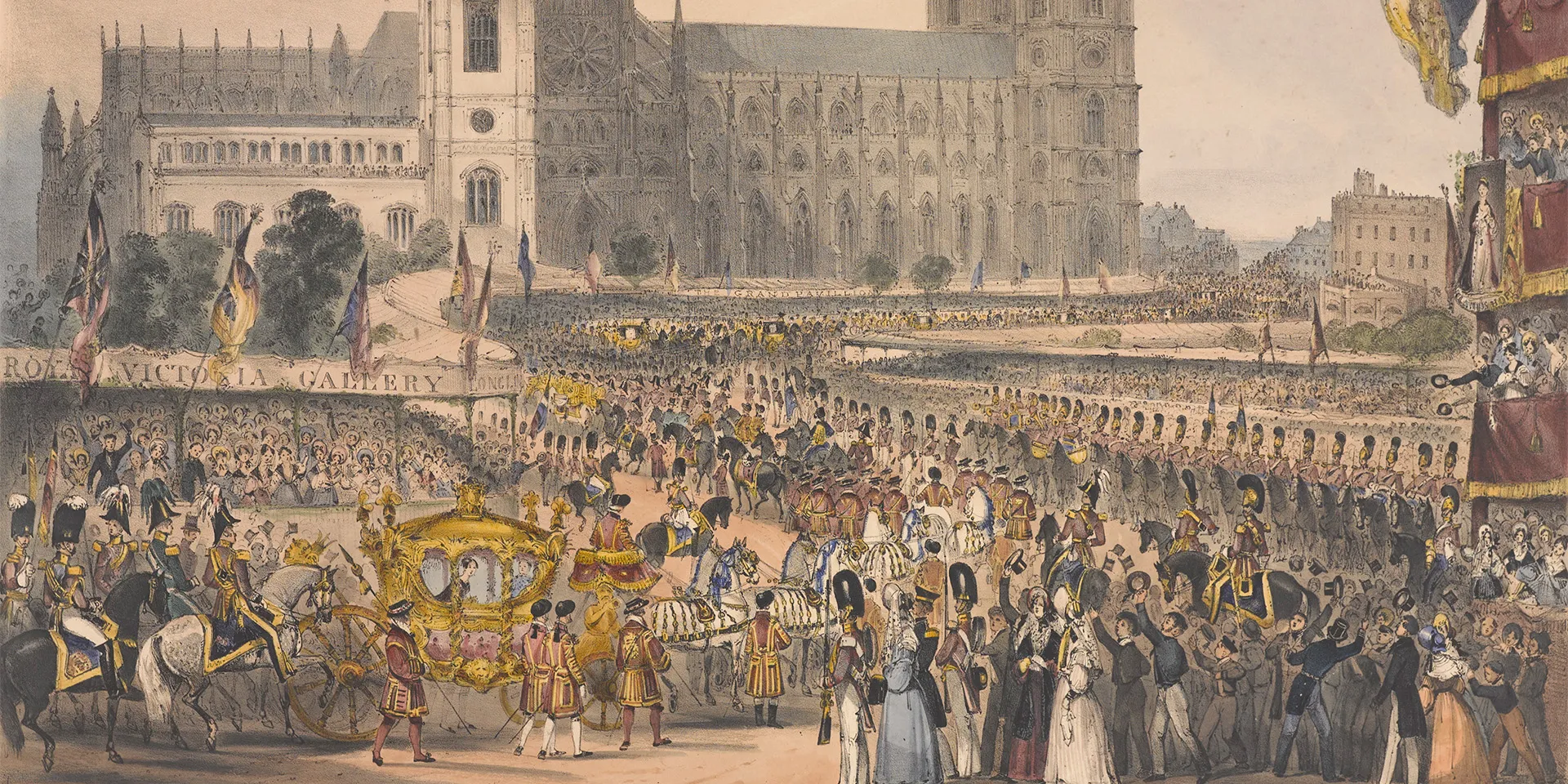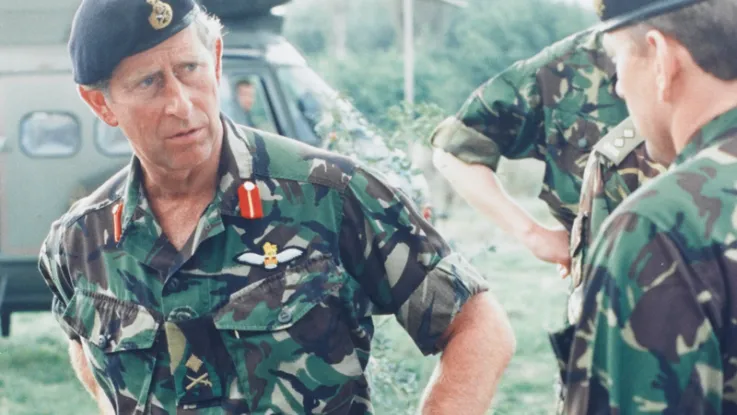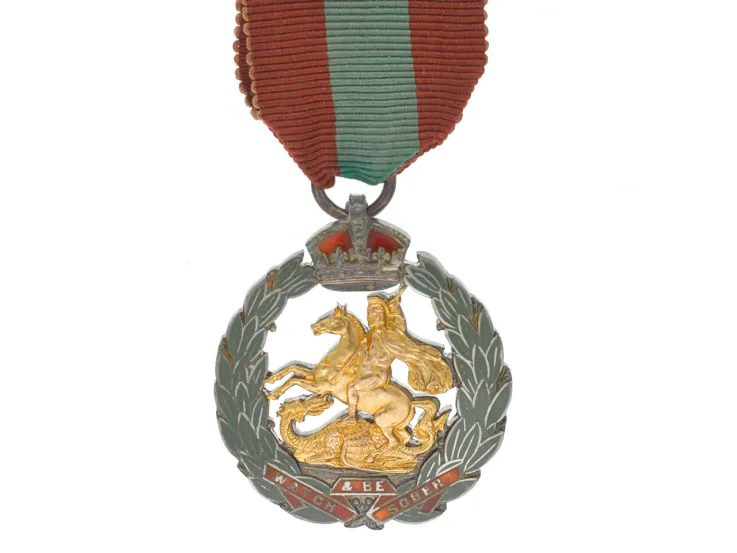
Queen Victoria Proceeding in State to Westminster, 28 June 1838
Early traditions
Medals have been struck to commemorate the coronation of every British monarch since King Edward VI in 1547.
The tradition of giving silver medals to those attending the ceremony at Westminster Abbey began in 1603 with the coronation of King James I. The medals were made by the Royal Mint and bore a Latin inscription that translates as: ‘James I, Caesar Augustus of Britain, Caesar the heir of the Caesars, presents this medal.’
According to records held by the Royal Mint, the number of coronation medals varied enormously from monarch to monarch. They were also minted in a variety of sizes and metals, including gold.

Medal commemorating the coronation of King George IV, 1821

Medal commemorating the coronation of Queen Victoria, 1838
The King’s Princely Largesse
There is little evidence confirming how these early coronation medals were distributed. Some were reserved for foreign ambassadors or given to the Speaker of the House of Commons for Members of Parliament.
At the coronation of King Charles I, the majority were shared out using a method known as ‘the King’s Princely Largesse’. These souvenirs were thrown into the crowd at Westminster Abbey by the Lord Treasurer of the King’s Household, the Garter Principal King of Arms and Black Rod. More were thrown to spectators on the processional route between the Abbey and Westminster Hall.
The coronation of King William IV in 1831 saw an undignified scramble for gold and silver medals thrown to the crowds in Westminster Abbey. Similar scenes took place at the coronation of Queen Victoria seven years later.
‘In the scramble for the pieces of silver, venerable judges, grave privy councillors, portly aldermen, Knights of the Bath, and general officers alike took part: the Guardsmen were very active in diving among the benches for these treasures, and two might be seen struggling for one medal; a few swords were snapped, and all rank was forgotten in the turbulent demonstration of loyalty.’Article in 'The Sun' — 1838
Formal distribution
Keen to restore decorum, King Edward VII adopted the practice already introduced by Queen Victoria in 1897 for the awarding of her Diamond Jubilee Medal.
His coronation medals were issued immediately after the event, instead of during the service. They were presented to people who had played a role in the arrangements for the ceremony or who served in a particular post or rank in the service of the country.
The medal bore the date ‘26 June 1902’. However, the ceremony ended up being postponed until 9 August after the King developed appendicitis.
Replicas
By a Royal Warrant of 1706, the Royal Mint is permitted to sell replicas of coronation medals. In addition, many unofficial commemorative medals have been struck in a variety of metals.
A number of unofficial medals were created to mark the coronation of King Edward VIII on 12 May 1937. Plans for that ceremony were abandoned when Edward abdicated, so no official medal was distributed. Instead, medals were hastily minted to commemorate the coronation of King George VI that took place on the same date.
‘The Durbar of George V, Emperor of India, Master of the British Land’Inscription (translated) on the Delhi Durbar Medal — 1911
Delhi Durbars
Coronations were also celebrated across the British Empire. In India, mass assemblies were held at Coronation Park in Delhi. Known as Delhi Durbars, these events formally announced the new monarchs to their imperial subjects.
The first was held in 1877 to proclaim Queen Victoria as Empress of India. Rather than coinciding with Victoria's coronation, this event marked the final transfer of political control from the East India Company to the British Crown. Subsequent Durbars were held in 1903 and 1911 to celebrate the coronations of Edward VII and George V respectively.
Gold and silver medals were struck for each of these occasions: the Empress of India Medal for the 1877 event; and the Delhi Durbar Medal in 1903 and 1911. The gold versions were awarded to Indian rulers and the highest-ranking officials; the silver medals went to other British and Indian dignitaries and military personnel.
The 1911 Durbar was by far the largest of these events, and the only one actually attended by the monarch. Around 50,000 officers and other ranks of the British and Indian armies were involved in the celebrations, but only a small percentage of these received a medal.
Coronation 2023
To commemorate the coronation of Queen Elizabeth II on 2 June 1953, around 130,000 official medals were struck. These were issued to chosen members of the royal household, the government, the Armed Forces and others in public service from Britain and the Commonwealth.
This longstanding tradition continues to the present day with a new medal issued to mark the coronation of King Charles III on 6 May 2023.











